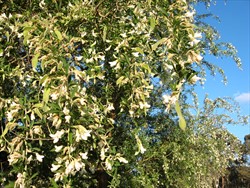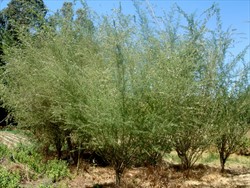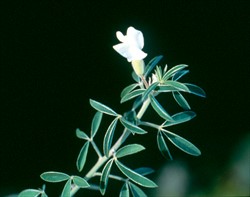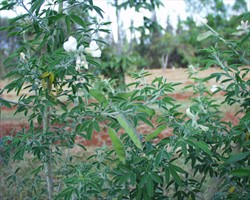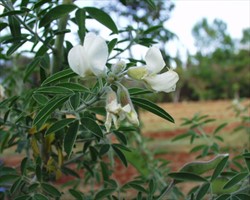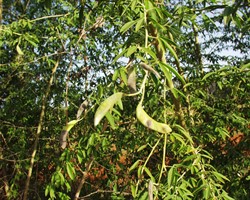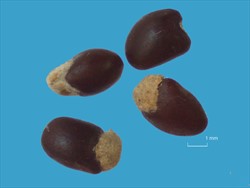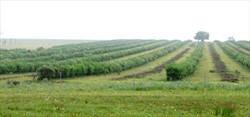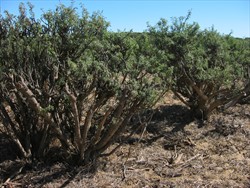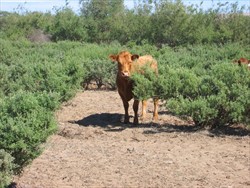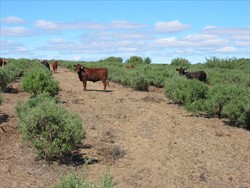Tropical Forages
Cytisus proliferus L. f. var. palmensis Christ
Conspecific taxa:
While 7 other varieties of Cytisus proliferus have been described (angustifolius, calderae, canariae, hierrensis, meridionalis, perezii, proliferus), all from the Canary Islands, var. palmensis is the only one cultivated as a forage.
Chamaecytisus palmensis (Christ) F.A. Bisby & K.W. Nicholls; Chamaecytisus proliferus subsp. palmensis (Christ) G. Kunkel; Chamaecytisus proliferus var. palmensis (Christ) A. Hansen & Sunding; Cytisus palmensis (Christ) Hutch.
Family: Fabaceae (alt. Leguminosae) subfamily: Faboideae tribe: Genisteae.
Perennial, evergreen, hardy, spreading shrub or small tree, 3‒5 (‒8) m in height, crown diameter similar size; branches long, weeping, unarmed; strong root system to 10 m where conditions suitable and feeder roots in top 1.5 m of soil extending to 15 m from trunk. Younger stems with soft grey pubescence. Leaves trifoliolate, grey-green, silky pubescent, alternate; petiole to 2 cm long; stipules minute or absent. Leaflets lanceolate, margins entire, upward-V cross section, glabrous above, silky pubescent below; terminal leaflet 1‒5 (‒7) cm long, 0.5‒1.5 (‒2) cm wide. Inflorescence a raceme, either axillary or terminal, at or near the ends of short lateral branches, each comprising 3‒8 flowers. Flowers pea-shaped, white to cream, fragrant, 16‒25 mm long; pedicels 7‒20 mm long, hairy, with 2 small filiform bracts arising below the calyx; calyx 9‒12 mm long, tubular and lipped, pale yellow-green, densely hairy, tube about 5 mm long, upper lip broad with 2 lobes joined for most of their length, lower lip with 3 short lobes; standard petal 14‒17 mm long, wings 13‒16 mm long, keel, 13‒16 mm, curved, slightly beaked. Pods oblong, pubescent, flattened, straight or slightly curved, 3‒5 (‒8) cm long, 0.8‒1.2 cm wide, grey to black when mature, containing to 10 seeds, elastically dehiscent along both sutures. Seeds oval-shaped, 5 mm long, 3‒5 mm wide, 1 mm thick, brown-black, with prominent strophiole. About 30,000‒45,000 seeds/kg.
English: tagasaste, silky cytisus, false tree lucerne, tree lucerne (not to be confused with tree alfalfa or tree medic, Medicago arborea L.)
Spanish: tagasaste, escobón (more appropriately applied to Cytisus proliferus varieties from islands other than La Palma in the Canary group); escobón negro, satagaste, tasagaste (Gran Canaria); tagasaste hembra, tagasaste mollar, tagasaste negro (La Palma)
Native:
Africa: Canary Islands (La Palma). While var. claderae is also endemic to La Palma, the other varieties are endemic to other islands in the the Canary group.
Naturalized:
Africa: Kenya; Canary Islands; Tanzania
Asia: India (Tamil Nadu)
Australasia: Australia (New South Wales, South Australia, Tasmania, Victoria, Western Australia); New Zealand
North America: U.S.A. (California)
Pacific: USA (Hawaii)
South America: Chile
Forage
Multi-purpose fodder tree for browse and cut-and-carry for cattle, sheep, goats, horses, chickens and game. It is a productive source of high quality, palatable and non-toxic fodder and seed in the tropical highlands and upland subtropics.
Environment
The evergreen hedges of tagasaste are used extensively as windbreaks and shelterbelts in drier regions. In Australia they have been used as green firebreaks.
Other
Also used as an ornamental, bee forage, and for fuelwood and biogas.
Var. palmensis occurs naturally between 700 and 1,300 m asl in the heath belt and laurel (Laurus novocanariensis) wood zones on the northern slopes of the island of La Palma in the Canary Islands, 28°40' N.
Soil requirements
Tagasaste prefers light, well-drained, sandy soils on slopes and hillsides, but thrives on gravels, loams, limestones and laterites. Slag heaps and mining dumps have reportedly been planted with the tree. It is adapted over a wide range of soil pH, and although growing better on acid soils with pH 5‒7, it can tolerate pH as low as 4.0, and sandy, alkaline soils with pH 8.5. It is not tolerant of salinity.
Moisture
It is extremely drought tolerant and thrives under annual rainfalls between 350 and 1,600 mm. Seedlings also are remarkably drought resistant surviving 6 months of hot weather without rain or irrigation. Drought tolerance is derived from its deep root system (to 10 m or more), surviving in areas with rainfall as low as 200 mm. However, it requires above 600 mm rainfall for good production. It is very sensitive to poor drainage and cannot tolerate waterlogging. Plants tend to die from fungal collar and root disease disease in tropical and subtropical areas with hot, wet summers.
Temperature
Tagasaste has been successfully grown from only a few metres above sea level at about 30° S to around 3,000 m asl at 9° N latitude. Growth of mature plants declines at temperatures below 20 °C. While it can tolerate temperatures up to 50 °C, leaves close up from stress above 36 °C. Mature plants have been observed to withstand temperatures down to -9 °C, and even as low as -15º C, although fresh growth might be burnt. Seedlings and small plants are less frost-tolerant and may be killed at temperatures below 0º C.
Light
Being a tree or shrub, shade tolerance in tagasaste is rarely an issue. However, by virtue of its native habitat in woodland, young plants may well have at least moderate shade tolerance. Seedlings rarely establish in dense shade.
Reproductive development
Profuse flowering occurs during the rains and early dry season in the tropical highlands or cool wet winter months in a Mediterranean climate. In the Mediterranean and temperate regions of southern Australia, flowers develop between June and October, with seed ripening in November‒December.
Defoliation
Young plants should be protected from browsing by livestock until well-established, which might take 2‒3 years. Trees coppice readily and, during the 2- to 3-year establishment period, can be pruned back to the ground to encourage multiple stems. Tagasaste responds well to frequent cutting, although regrowth is slow for the first weeks after harvest, increasing with time. Plants should be maintained according to class of stock browsing, 1.5 m for cattle and 50‒70 cm for sheep. Maintain stocking rates to prevent loss of production through flowering. To prevent flowering, graze or cut tagasaste to less than 1.5 m before spring. Harvesting in the dry season leads to stunted regrowth, low biomass yields and increased plant mortality. When young, sheep will eat the bark and kill the tree if it is not protected, but once well-established, sheep can browse them all year round and have a remarkable capacity to recover from defoliation. It is reported that trees persist for 30 years or more if well managed.
Fire
Tagasaste stays green during the dry season and does not burn readily.
Guidelines for establishment and management of sown forages.
Establishment
Tagasaste is hard-seeded so seeds require scarification prior to planting. This is done by dropping the seed into boiling water at about 1 kg of seed to 4 L of water, then immediately removing the container from the heat source and allowing the seed to soak in the water as it cools. Successfully treated seed swells and can be sieved off. Seedbeds should be well prepared to a fine, firm tilth with no weeds. Weed control is essential for successful establishment. Seed should be inoculated with rhizobium strain CC 1502 or similar to ensure effective nodulation. Seeds can be directly sown at sowing depths of 1‒2.5 cm, although deeper sowing may be necessary in sandy soils in dry areas to ensure sufficient water for germination. While tagasaste can also be established by transplanting nursery-raised seedlings, care should be taken not to over-water the young seedlings to avoid damping off. Seedlings of about 45 cm height can be transplanted into moist soft soil in rows 5 m apart and 2.5 m between plants in the row, giving a density of about 700 trees per hectare. Very high densities of up to 10,000‒20,000 seedlings/ha have also been used successfully.
Fertilizer
Tagasaste is well-adapted to low fertility soils, having the ability to extract phosphorus efficiently from low P soils. However, applications of up to 200 kg/ha/year of superphosphate may be needed in soils of very low fertility if high yields are to be maintained. Lime is rarely required. Manganese deficiency that can occur on deep sands or alkaline soils can be overcome with application of 40 kg/ha of manganese sulphate. Deficiency, symptoms of which include reduced plant vigour and leaf yellowing, can be confirmed by tissue analysis .
Compatibility (with other species)
It can be used in alley farming and is an excellent windbreak.
Companion species
Subtropical grasses such as Setaria sphacelata and Chloris gayana can be grown in the interrow area, but should not be introduced until the tagasaste is well-established.
Pests and diseases
Insect pests vary from country to country, but overall, tagasaste has few serious insect pest problems. In Australia, it is susceptible to the tree lucerne moth (Uresiphita ornithopteralis, Crambidae), slugs, cutworms and grasshoppers that eat emerging seedlings. Infestations of nymphs of Rutherglen bug (Nysius vinitor, Heteroptera: Lygaeidae) can kill seedling plants. In New Zealand, stem boring insects such as the lemon tree borer (Oemona hirta, Cerambycidae) and Puriri moth (Aenetus virescens, Hepalidae) contribute to reducing the shrub’s average life span to 10‒12 years in the North Island.
Tagasaste is very sensitive to root disease caused by Phytophthora and Fusarium, favoured by even short periods of waterlogging. These are major limitations to its use in humid areas or on vertisols. Injury caused by browsing animals stripping the bark from mature plants has permitted enry of Phytophthora fungus causing plant death.
Ability to spread
Spreads by seeds from the dehiscent pods. However, hard seeds may not germinate in the soil for several years. Since developing plants are browsed by native and introduced fauna in most countries, their survival is limited to protected or fenced areas.
Weed potential
A fast growing species used for fodder and is invasive in a wide rage of landscapes. It has naturalized in almost all areas where it has been planted, along roadsides or in adjacent bushland. If ungrazed, it is a serious invader of disturbed bushland on lateritic soils in higher rainfall areas.
Nutritive value
The nutritive value of leaves is similar to that of lucerne (Medicago sativa ). Leaves contain 20‒30% protein when young with high in vitro dry-matter digestibility (0.77‒0.82%) and no reported toxicity. The leaves have a low sodium content and marginal levels of phosphorus and sulphur. Mineral licks are recommended when feeding tagasaste due to the low levels of minerals in the leaves. Leaves are high in vitamin A and when used for poultry feed, can increase the colour in egg yolks.
Palatability/acceptability
The leaves are reported as highly palatable. However, livestock take a little time to get used to it as a feed, and crossbred dairy cows in Ethiopia would not consume large quantities of wilted forage, resulting in reduced dry matter intake. Potassium is thought to increase tagasaste palatability and may also be beneficial.
Toxicity
Tagasaste has been fed to sheep for long periods without any problem and there are no reports of toxicity in sheep, cattle, goats, deer or poultry. Levels of tannins are low. No cases of bloat have been reported after feeding with tagasaste. A disease referred to as tagasaste staggers has been observed with cattle and goats browsing tagasaste. Affected animals show a range of symptoms, from trembling in the muzzle to whole body staggers, some even collapsing and convulsing. The cause is unknown, but affected animals usually recover in less than 30 minutes if left undisturbed. Death is rare.
Feedipedia link
Dry matter
Research results from Western Australia and New Zealand suggest edible dry matter yields of 11 t/ha/yr are obtainable in good growing conditions. Edible biomass yields of about 5 t/ha were obtained after 6 months regrowth in the Ethiopian highlands.
Animal production
Growing lambs showed liveweight gains of 95±30 g/day on a cut and carry system with tagasaste in New Zealand and up to 35 g/day when supplemented with 60% of the diet in Ethiopia.
While there is considerable genetic diversity in remaining wild populations of the species, it is assumed that the genetic base of early exports of seed to Australia and New Zealand is very narrow. Both self and cross-pollination occurs, as the flowers are self fertile and often cross-pollinated by bees. 2n = 48, rarely 50.
Tagasaste is a prolific seeder. The pods ripen in the dry season and are dehiscent. Pods are usually harvested before shattering and dried in thin layers in the sun to release the seeds.
Tagasaste is tolerant to a range of herbicides applied pre-emergence, including those containing simazine, diuron, terbutryne, alachlor, fluazifop-butyl, linuron, propyzamide and methabenzthiazuron. Individual plants can be killed using the cut stump approach, immediately painting the cut surface with neat glyphosate.
- Extremely drought tolerant.
- Fast growing, palatable, high quality fodder.
- Frost tolerant.
- Does not tolerate poor drainage or waterlogging .
- Young plants are easily eaten out and must be protected from grazing.
- Suited to limited areas in tropical and subtropical environments.
Assefa, G. (1998) Biomass yield, botanical fractions and quality of tagasaste (Chamaecytisus palmensis) as affected by harvesting interval in the highlands of Ethiopia. Agroforestry Systems 42:13–23. doi.org/10.1023/A:1006099521986
Borens, F.M.P. and Poppi, D.P. (1990) The nutritive value for ruminants of tagasaste (Chamaecytisus palmensis), a leguminous tree. Animal Feed Science and Technology 28:275–292. doi.org/10.1016/0377-8401(90)90159-6
Snook, L.C. (1982) Tagasaste (tree lucerne): a shrub with high potential as a productive fodder crop. Journal of the Australian Institute of Agricultural Science 48:209–214.
Townsend, R.J. and Radcliffe, J.E. (1990) Tagasaste forage production systems. New Zealand Journal of Agricultural Research 33:627–634. doi.org/10.1080/00288233.1990.10428467
Varvikko, T. and Khalili, H. (1993) Wilted tagasaste (Chamaecytisus palmensis) forage as a replacement for a concentrate supplement for lactating crossbred Friesian × Zebu (Boran) dairy cows fed low-quality native hay. Animal Feed Science and Technology 40:239–250. doi.org/10.1016/0377-8401(93)90160-L
Wiley, T. (2006) Fodder shrubs. In: Moore, G.A., Sanford, P. and Wiley, T. (eds) Perennial pastures for Western Australia. Bulletin 4690. Department of Agriculture and Food, Western Australia, Perth, WA, Australia. https://researchlibrary.agric.wa.gov.au/bulletins/1/
Note: Tagasaste is mostly sown using seed derived from early introductions of the species.
'Cleavers Easy Graze' or 'Weeping tagasaste' is a low-growing, weeping form selected from a sown stand by a farmer in Western Australia.
'ILRI 15076' (AL 2251) Released in Ethiopia. Seed initially imported from New Zealand. Distributed by Eden Field Agri-Seed Enterprise, Addis Ababa.
ILRI 15378 Selected in Ethiopia. Tolerant to acid soils and produces edible biomass yields of about 6 t/ha after 1 year's growth.
AL2244 and AL2432 Selected from 16 lines in New Zealand, primarily for high survival, but also rated well for other attributes including habit and production.
